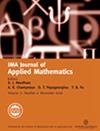利用Euler-Poisson-Darboux方程加速八卦算法
IF 1.4
4区 数学
Q2 MATHEMATICS, APPLIED
引用次数: 0
摘要
本文研究了离散时间图上的八卦算法及其加速算法。在这项工作中,我们采取了不同的方法,并考虑了八卦算法在大图和大量迭代中的缩放极限。这些极限导致了众所周知的具有深刻性质的偏微分方程(PDEs)。在格上,我们证明了(??)的非加速八卦算法收敛于热方程,(??)的加速雅可比多项式迭代收敛于欧拉-泊松-达布(EPD)方程-一种阻尼波动方程。值得注意的是,在适当的参数下,EPD方程的基本解具有理想的八卦行为:椭球体上的均匀密度,其半径以与$t$成比例的速率增加-这是局部通信八卦算法的最快速率。这与热方程相反,其中密度以典型的尺度$\sqrt {t}$扩散。此外,我们还提供了仿真,证明了八卦算法可以通过其极限偏微分方程精确地近似。本文章由计算机程序翻译,如有差异,请以英文原文为准。
Acceleration of Gossip Algorithms through the Euler–Poisson–Darboux Equation
Gossip algorithms and their accelerated versions have been studied exclusively in discrete time on graphs. In this work, we take a different approach, and consider the scaling limit of gossip algorithms in both large graphs and large number of iterations. These limits lead to well-known partial differential equations (PDEs) with insightful properties. On lattices, we prove that the non-accelerated gossip algorithm of (??) converges to the heat equation, and the accelerated Jacobi polynomial iteration of (??) converges to the Euler–Poisson–Darboux (EPD) equation — a damped wave equation. Remarkably, with appropriate parameters, the fundamental solution of the EPD equation has the ideal gossip behaviour: a uniform density over an ellipsoid, whose radius increases at a rate proportional to $t$ — the fastest possible rate for locally communicating gossip algorithms. This is in contrast with the heat equation where the density spreads on a typical scale of $\sqrt {t}$. Additionally, we provide simulations demonstrating that the gossip algorithms are accurately approximated by their limiting PDEs.
求助全文
通过发布文献求助,成功后即可免费获取论文全文。
去求助
来源期刊
CiteScore
2.30
自引率
8.30%
发文量
32
审稿时长
24 months
期刊介绍:
The IMA Journal of Applied Mathematics is a direct successor of the Journal of the Institute of Mathematics and its Applications which was started in 1965. It is an interdisciplinary journal that publishes research on mathematics arising in the physical sciences and engineering as well as suitable articles in the life sciences, social sciences, and finance. Submissions should address interesting and challenging mathematical problems arising in applications. A good balance between the development of the application(s) and the analysis is expected. Papers that either use established methods to address solved problems or that present analysis in the absence of applications will not be considered.
The journal welcomes submissions in many research areas. Examples are: continuum mechanics materials science and elasticity, including boundary layer theory, combustion, complex flows and soft matter, electrohydrodynamics and magnetohydrodynamics, geophysical flows, granular flows, interfacial and free surface flows, vortex dynamics; elasticity theory; linear and nonlinear wave propagation, nonlinear optics and photonics; inverse problems; applied dynamical systems and nonlinear systems; mathematical physics; stochastic differential equations and stochastic dynamics; network science; industrial applications.

 求助内容:
求助内容: 应助结果提醒方式:
应助结果提醒方式:


